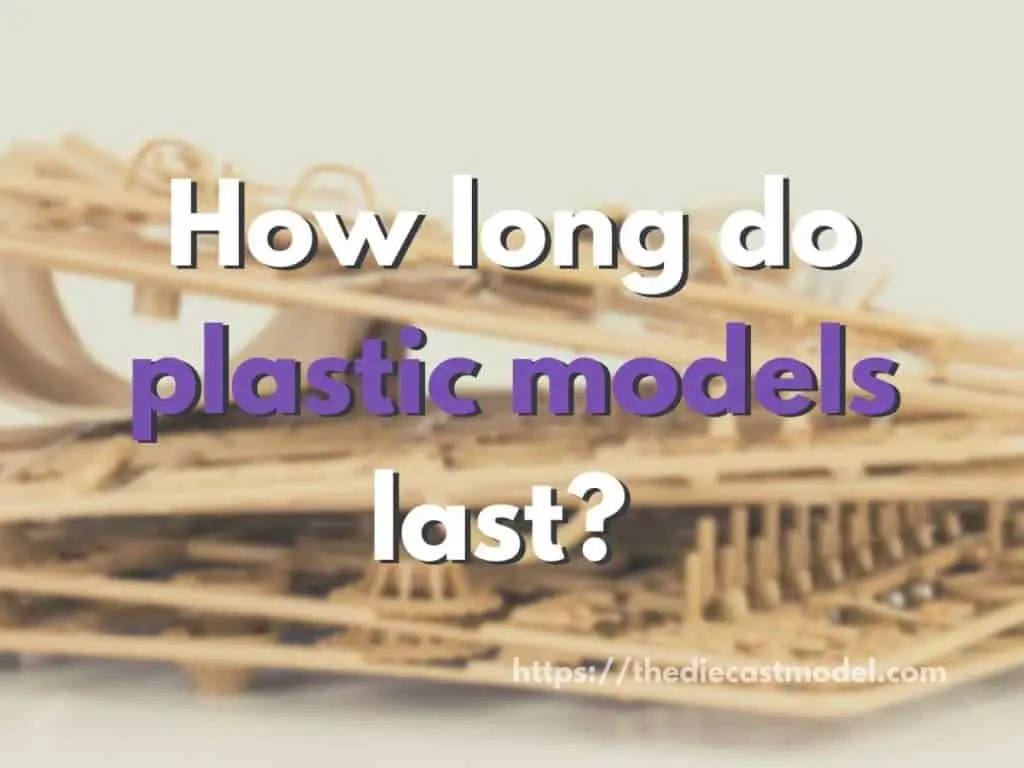How long do plastic models last? Signs to Look for If Plastic Models are Deteriorating and Ways to Take Care of your Models
One of the proudest moments for a modeler is when they finally finished their model. No matter the brand, quality, or difficulty, most of us will be proud of seeing the finished result. However, the next question when we finally built our plastic model is how long do these last? What can we do to take care of and prolong its lifespan?
Generally speaking, the average lifespan of a plastic model is 10 years. However, if it is well stored and taken care of, it can last 50 to 60 years or even more. However, plastic models that aren’t taken care of and stored in an unfavorable environment would not even last 5 years.
This blog post will talk about the things to note when taking care of your models. What are the things to look for and simple tips on taking care of your models?

How long do plastic models last?
The average life span of a plastic model is 10 years. With proper maintenance, a plastic model can last more than 60 years. Plastic models last depending on how much a person cares for their models.
Plastic models are fantastic for collectors who want to test their imaginative skills.
Many people collect plastic models as a hobby. Unfortunately, these people often store their collections in glass cases or under protective shelves that can maintain an appropriate level of humidity which dramatically affects the lifespan of plastic models.
Over time, plastic models get brittle and yellowish. This is due to age and can be caused by oxidation.
Furthermore, oxidation can accelerate due to mold and bacterial growth. It has been shown that molds can penetrate the surface of plastics, which can cause them to crack or even deteriorate.
Chemically speaking, the deterioration of plastic models can be attributed to depolymerization.
In scientific terms, the deterioration of plastic models comes from a concept known as depolymerization. Plastic models are made with petroleum which has a sturdy construction. However, these bonds tend to weaken through time, which causes these models to depolymerize.
This polymerization causes deterioration which is apparent when plastic models become brittle or change in color.
Later, we will talk about what we can do to lessen the depolymerization rate. Thanks to numerous protective agents, we can prevent the causes of polymerization.
Furthermore, if the plastic model has metals in it, this can cause lead rot which is common to metal models produced before the 80s. However, thanks to strict safety regulations by the government, the lead amount in metal models has been controlled.
In another blog post, I talked about the amount of lead in models and why they are now generally safe. You may find it here.
However, I didn’t talk in that article about how the reduction of lead made models last longer due to the lesser occurrence of lead rots.
Lead rots are what you see on metal models when discoloration and cracks on the metal. Lead rots have been lessened by reducing the lead amount in models to safe levels.
Generally speaking, while this is the case, plastic models tend to last for about 20 to 30 years. However, if taken care of properly, they can last more than 60 years. In addition, there are techniques you can do to preserve these plastic models.
Some think that plastic models can last 50 to 60 years without effort. However, plastic models that aren’t taken care of can sometimes break in a few years.
For example, frequent exposure to moisture not only increases the odds of oxidation on plastic models but also increases the likelihood of molds that deteriorate the plastic’s integrity. That’s why some modelers tend to put dehumidifier beads on their storage.
Furthermore, manufacturers of plastic models tend to put some dehumidifier beads together with a tightly sealed box to preserve the plastic models.
When I was a child, I had a Gundam plastic model, which I stored in my attic, subjected to immense temperature change. It broke down in just about 3 years. That’s where the 9-year-old me learned how important it is to take care of my plastic models if I want them to last a long time.
The good news is these plastic models don’t deteriorate instantly. However, there are some warning signs you can look for to know if the model is not taken care of properly. That’s what I will talk about in the next section.
Recommended Video: Check how I build my Model to protect it from plastic aging here:
Signs that your Plastic Model is Deteriorating
You will know if your plastic model deteriorates if the plastics turn yellow and brittle. This is because plastics tend to depolymerize with age which causes them to lose their structural integrity. Furthermore, mold and dust can accelerate the degradation of plastic models by accelerating oxidation and penetrating plastics.
Here are the signs you should look for to tell if your plastic model is deteriorating.
1. Yellowing or Discoloration of Plastics
Decoloration of plastics is one of the easiest ways to know if your plastic model is deteriorating.
Decoloration of plastics can be attributed to numerous factors, but the most common reason is the depolymerization and oxidation of plastics.
Generally speaking, plastics are made of petroleum, which is prone to oxidation. Oxidation is also why cooking oils tend to change color upon frequent use.
This color change is usually caused by oxidation.
Plastic models tend to change color upon oxidation, and there are numerous ways to accelerate the process, such as bacterial growth and exposure to light and air.
That’s why some modelers protect their plastics by painting them. However, by experience, painting isn’t enough. To fully protect plastics from oxidation, primers and protective coating are necessary.
It can be hard to detect discolorations if you’re a beginner in plastic modeling. However, you can easily spot them on white and green plastic kits.
2. Plastics Becoming Brittle
Plastics that are deteriorating become brittle. That’s why most plastics tend to break when they are old easily.
Plastics becoming brittle is also due to the depolymerization of plastics. When plastics are new, their molecules are arranged in a strong formation known as polymers. However, through time, they tend to lose this solid structural integrity.
When plastics depolymerize, they become weaker. That’s why plastics tend to be more elastic and robust than older ones.
However, this change is gradual. In fact, when plastics become incredibly brittle, there is no way we can return them to normal.
Plus, it is better to look for discoloration since it is easier to detect than brittleness.
However, if your models are made in the 80s or older, there is another way to know if it is deteriorating by looking at their metal components.
3. Lead Rots
Some plastic models tend to have metals in them. Before, metals used in plastic models tended to have lead. This lead turns to lead rots through time.
That’s also why old metals tend to go black or have a bubbly surface. But, again, this is most likely caused by lead rots.
When old models, particularly those made in the 80s below, form these, these are signs that the model isn’t correctly taken care of.
Lead rots are usually caused by oxidation, and if these metals are oxidized, there is a high chance that the plastics are also oxidized.
Newer models don’t and should exhibit these lead rots thanks to stricter regulations on lead. So this could only apply to old models.
4. Mold Growth
If a plastic model is stored in a dark and humid environment, there is a high chance that mold can grow to it.
Molds not only accelerate the oxidation process but also penetrate plastics. This means when they start penetrating plastics, oxidation can begin happening from the inside.
This is also why some modelers tend to clean their models. However, please note that some cleaning products can melt the paint of the models causing them to have a higher exposure to these molds.
The easiest way to prevent mold growth is to add a dehumidifier bead or, if you have a room full of models, a dehumidifier machine. The reduction of humidity can prevent the development of molds.
5. Dust and Oil Accumulation
Dust and oil accumulation is a clear sign that your plastic models aren’t stored properly, and your models aren’t correctly taken care of.
Because of dust and oil, plastic models tend to be prone to bacterial growth, penetrating plastics, and accelerating oxidation.
That’s why proper storage is necessary. If possible, store them in a sealed container. Furthermore, keeping your models in mint condition can also help.
Now that you have some things to look for to know if your models are not taken care of properly, what are some easy ways to expand their lifespan? That’s our topic in the next section.
How to Maximize the Lifespan of your Plastic Models
The best way to maximize the lifespan of plastic models is to store them in an environment free from sudden temperature change and UV. UV exposure increases the rate of degradation of plastic polymers. Furthermore, plastics are temperature sensitive which can cause them to deform. You may also use protective agents such as primers to protect your models.
1. Prime your Models
Most new modelers tend to skip priming when painting their models. This is a bad idea for two reasons.
- Priming makes sure that the paint sticks with the plastic. This prevents bubbles which can cause oxidation inside the paint and plastic.
- Primers serve to protect the plastic from external stress.
One of the best ways to protect your models is to use a primer. This can coat your model from the inside. It also makes sure that the paint sticks to the primer leaving no bubbles when painting.
Remember that air exposure leads to oxidation. That’s why air bubbles on the painting don’t only look bad, but it’s also bad for the lifespan of your plastic model.
I made a blog post about why you should prime models in another post. You can find it here: Do you really need to prime models?
2. Put a Dehumidifier
Dehumidifiers remove excess water from the air. Water is one of the main contributing factors for bacterial and mold growth.
As we talked about earlier, mold and bacteria accelerate the deterioration process and can also penetrate the insides of plastics.
That’s why putting dehumidifier beads or dehumidifier machines can maximize the lifespan of your models.
The good news is that dehumidifier beads come cheap in local stores or even online. If you’re on a tight budget, you can also use the ones included when you buy new shoes.
3. Store Models in a Safe Place to Prevent Heat, Cold, and UV light
Plastics are temperature sensitive. That’s why a good storage area for models should be somewhere where the temperature doesn’t change a lot. Furthermore, the temperature should not reach extremely low or high.
Remember my story where I stored them in our attic? Unfortunately, our attic tends to change the temperature a lot. That’s why the depolymerization process of my plastic model accelerated.
Furthermore, I was young and didn’t know how to prime or coat models.
Remember to have safe storage for your models. Ensure it is away from extreme heat, cold, and UV light.
A general rule of thumb is to store it in an insulated environment. This means storage that doesn’t absorb heat.
It doesn’t need to be fancy. In fact, the boxes included with plastic kits are good insulators. They also protect the kits from UV light.
4. Apply Clear Coat on Paints
You might already use a primer and paint. Now, you have two protective coating to prevent oxidation on your plastic kits.
You can make things better with a clear coat.
A clear coat not only makes your model shiny but also adds another layer of protection for your model.
Furthermore, it protects oxidation in your paint. This means your paint will generally last longer if you apply a clear coat.
If you already took the time to put some primer and paint, it would be wise to add a clear coat to protect your plastic model and the paint further.
5. Wax your Models
Lastly, if you want your models to shine, you can wax your models. Waxing adds a protective layer that can last for weeks or months.
This is an excellent addition to protect the clear coat. However, this is optional.
Furthermore, if you decide to wax your models, make sure not to wax your models often because frequent waxing can melt your clear coat.
Thus, waxing your models quarterly to protect your paint and clear coat from UV is advisable.
As a bonus, some wax offers extra UV protection, which is ideal for preserving the paint.







